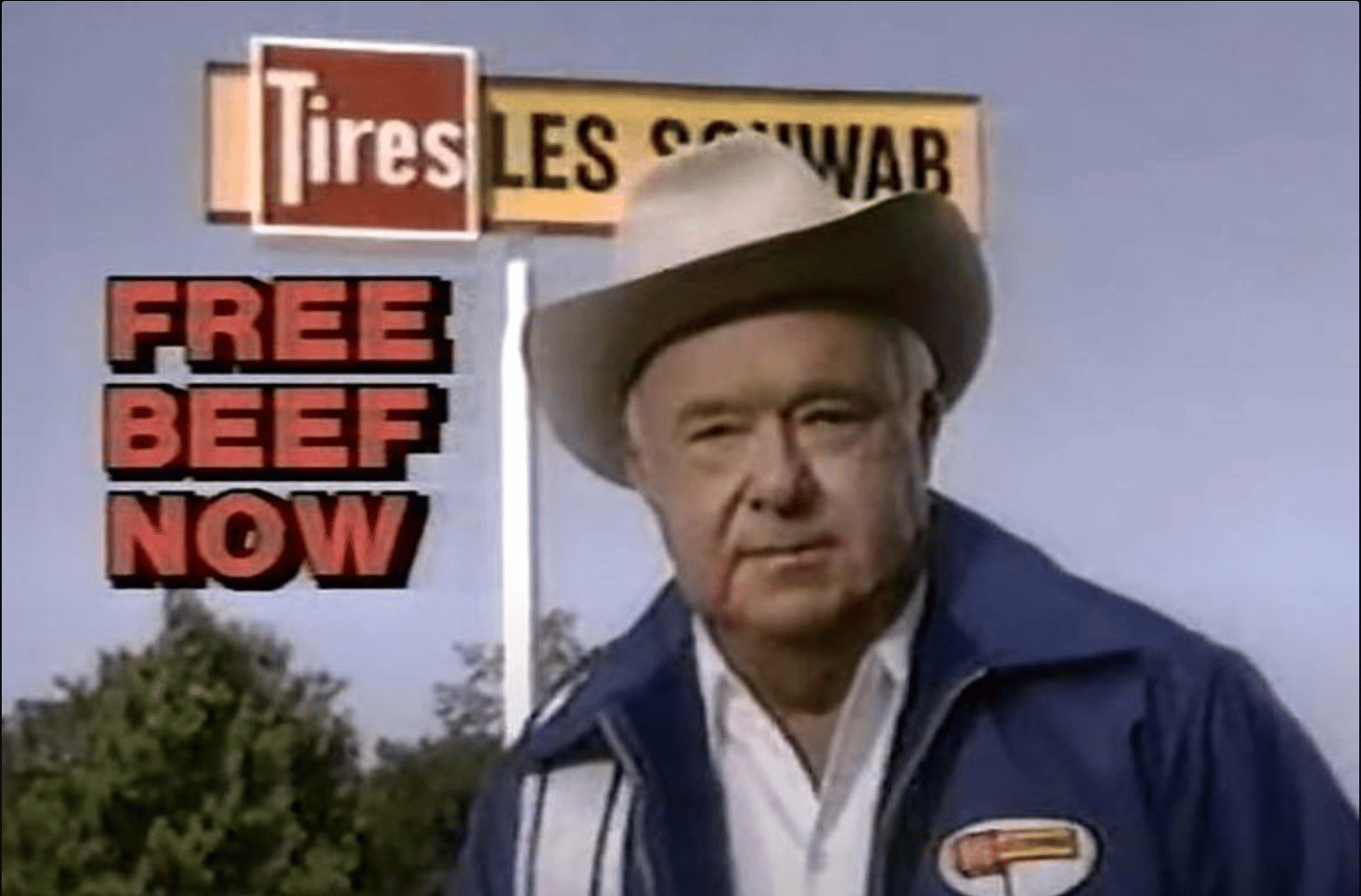- Methods of Prosperity
- Posts
- Don’t Waste Your Time on Anything Else. Get Incentives Right.
Don’t Waste Your Time on Anything Else. Get Incentives Right.
Methods of Prosperity newsletter no. 109: Les Schwab

How can someone give away fifty percent of profits and make billions more than if he’d kept it all?”
Most business owners struggle in six areas:
They lack perfect alignment of incentives.
They lack generosity.
They don’t require reinvestment.
They lack supplier diversity.
They don’t build culture first.
They fail to maintain transparency.
But after studying Les Schwab, you can do better.
I figured that if I was going to work that hard building a business, I’d want half the profits. So I decided anyone working that hard for me should get half the profits too.”

Les Schwab (1917-2007)
Les Schwab was an American businessman. He was best known as the founder of Les Schwab Tire Centers, a major tire retail chain in the western United States.
He was born on October 3, 1917 in Bend, Oregon. When the Great Depression hit, the bank took back his family’s farm. After that, his family lived in a logging camp without running water. There was one community shower.
He had no education beyond eighth grade. To support himself, he worked as a newspaper distributor starting at age twelve. Without a bike. He delivered newspapers on foot for the first two months. He ran over nine miles every day. He had to save money to buy a used bike. He was too proud to complain.
January 1933. His mother died from pneumonia. His father was a drunk. He died outside of a moonshine joint. That made Les an orphan before the age sixteen.
It was the middle of the Great Depression. There were eight or nine newspaper routes. Les Schwab worked all of them. He was earning around $175–$200 per month. His school principal only earned $150 per month.
Les got married at age eighteen. He stayed in the newspaper business for the next fifteen years. Bend Bulletin recruited him as circulation manager. That’s when he realized it’s possible to know more than anyone else about a certain thing.
I’ve mentioned this before in previous editions of this newsletter. Naval Ravikant calls it specific knowledge. Les Schwab knew more about the newspaper business than any of his bosses. In reality, it’s a sales job.
Les Schwab had a natural ability. He possessed an innate talent for sales, persuasion, marketing, and advertising.
During World War II, he served in the Army Air Corps. He was twenty eight years old. After the war, he resumed his newspaper work. But he became dissatisfied working for someone else. At the age of thirty three, he decided to go into business for himself. The only problem was, he had no experience in another profession.
Did that stop him? Of course not. His brother-in-law offered to finance whatever business that Les decided to go into. Les believed he was running out of time. If a man waits too long to start a business, the runway becomes too short. He will get into a rut and never make it happen.
Instead of overthinking, Les chose to buy a franchise. In 1952, Schwab purchased OK Rubber Welders. It was a small tire store in Prineville, Oregon. Les borrowed $17,000. Then he built a tire retail empire.
He did it through a relentless focus on customer service. Practices like running out to greet customers and keeping showroom tires clean. Schwab introduced the concept of showroom tire sales.
He was a genius at marketing (“Free Beef in February” promotion). His legendary “Walnut for Ice, Sawdust for Snow” campaign emerged from his observation. The manufacturers mix both walnut shells and sawdust into the rubber. Both materials were in the tires anyway. Les invented a reason. Customers believed Les Schwab tires were superior to other brands for this reason.
If his marketing alone wouldn’t grow his business, employee profit-sharing would.
He grew Les Schwab Tire Centers into a Fortune 500 company with over $1.6 billion in annual sales. His success came from innovative solutions to two critical business challenges:
eliminating agency costs through revolutionary profit-sharing.
bypassing monopolistic tire manufacturers through strategic sourcing.
What is agency cost? It’s the Principal vs. Agent problem. A principal is an owner; an agent is an employee. A principal’s incentives are different than an agent’s incentives.
“As a business owner you are always going to be dealing with the principal-agent problem. You’re always going to be trying to figure out: How do I make this person think like me? How do I incent them? How do I give them founder mentality?”
The other big problem with the tire business of that era was the oligopoly of tire manufacturers. All the rubber companies are American and they dominate the market. They colluded on pricing. Les Schwab became independent (fighting with the franchisor), competing against them. The big American companies won’t sell to Les at a fair price, so he goes to a Japanese supplier. It was the Toyo Tire Company. At the time, they were the only foreign tire supply.
Charlie Munger mentioned that Les Schwab competed
“with the stores that were owned by the big tire companies that made all the tires”
And later, massive discounters like Costco and Sears. Schwab succeeded in the challenging tire retail industry.
By the time of his death in 2007, Les Schwab Tire Centers had expanded to hundreds of locations. He had thousands of employees. Les Schwab Tire Centers was one of the largest independent tire retailers in the country. Schwab’s management philosophy emphasized treating both customers and employees like family. His legacy continues to shape the company's culture today. The company remained family-owned until its acquisition by Meritage Group LP in 2020.
New! Notice there’s only one action for you to take. We’re building our core group of people who want to invest together. You can now join our Methods of Prosperity community on Telegram here:
I like you,
– Sean Allen Fenn
PS: I’m giving you the details about how Les Schwab solved those two critical business challenges. Remember? I mentioned this at the beginning. Here they are:
Part 1: Eliminating Agency Costs Through Ownership-Based Incentives
The Revolutionary 50/50 Profit-Sharing Model
Les Schwab’s most innovative solution to agency problems? His radical profit-sharing structure:
Core Structure:
50/50 profit split with store managers - unprecedented in retail
Managers received 50% of their store's profits after covering costs
Over 51% of total company profits shared with employees before taxes
Created true ownership mentality without legal ownership transfer
Psychological Impact:
Transformed employees from “hired help” to business partners
Eliminated the principal-agent problem by aligning interests
Managers acted like owners because Les treated them as owners
Created powerful word-of-mouth recruiting as success stories spread
Mandatory Reinvestment: “Skin in the Game”
Schwab solved the problem of short-term thinking through a clever reinvestment requirement:
The Mechanism:
Managers had to reinvest their profit distributions back into new store locations
This created compound growth incentives - success bred more success
Prevented managers from taking profits and becoming complacent
Built long-term wealth while maintaining growth momentum
Results:
Managers became wealthy through compound reinvestment
Company expanded through manager-funded growth
Created a self-selecting system where only committed people stayed
Anti-Dishonesty Systems
Zero Tolerance Policy:
Immediate termination for any dishonesty, regardless of amount
Applied to all levels - no exceptions for top performers
Created culture where integrity was non-negotiable
Prevented the "small compromises lead to big corruption" problem
Transparency Mechanisms:
Open book management - employees could see all financial data
Profit and loss statements shared with all staff
Performance metrics visible across all stores
Created accountability through visibility
Personnel Selection:
Hired for character first, skills second
Promoted exclusively from within to maintain cultural integrity
Long evaluation periods to assess trustworthiness
Created strong cultural barriers against dishonest behavior
Part 2: Breaking Manufacturer Monopolies Through Strategic Sourcing
The Japanese Tire Revolution
Market Context (1950s-1970s):
American tire manufacturers (Goodyear, Firestone, General) operated as oligopoly
Fixed pricing, limited innovation, poor dealer terms
Manufacturers dictated terms to dealers with little negotiation
Quality was inconsistent, yet prices remained high
Schwab’s Strategic Response:
Early adoption of Japanese tire manufacturers (Bridgestone, Michelin entering US)
Negotiated direct with manufacturers for better terms
Bypassed traditional distribution chains
Created competitive pressure on American manufacturers
Supplier Diversification Strategy
Multi-Source Approach:
Never became dependent on single manufacturer
Maintained relationships with 6-8 major tire brands
Could play suppliers against each other for better terms
Created backup options if one supplier became difficult
Volume Leverage:
Built scale fast through profit-sharing expansion
Used combined volume across all stores for better pricing
Negotiated exclusive regional deals in some cases
Achieved purchasing power rivaling national chains
Quality Focus:
Emphasized tire performance over brand loyalty
Educated customers about tire technology, not only brand names
Built reputation on actual performance rather than manufacturer marketing
Could drop underperforming brands without customer loss
Vertical Integration Elements
Les Schwab Brand Development:
Created private label tires for certain applications
Controlled quality and margins on specialty products
Reduced dependence on major manufacturers for some segments
Built customer loyalty to "Les Schwab" rather than tire brands
Service Integration:
Combined tire sales with installation and service
Created recurring revenue streams beyond tire sales
Made customer relationship less dependent on any single manufacturer
Built switching costs for customers through service relationships
Part 3: The Munger-Buffett Analysis
Charlie Munger’s Four Success Factors
Munger identified Schwab’s key advantages:
Capitalizing on Japanese Tire Invasion: Early recognition and adoption of superior Japanese tires
Strong Incentive Structure: The 50/50 profit-sharing that eliminated agency costs
Clever Personnel Selection: Hiring for character and promoting from within
Effective Advertising: Building brand recognition despite manufacturer competition
Competitive Moats Created
Human Capital Moat:
Profit-sharing created employee loyalty impossible to poach
Competitors couldn't match compensation without destroying margins
Cultural advantages compound over time
Operational Excellence:
Service standards maintained through profit incentives
Customer satisfaction drove repeat business and referrals
Operational efficiency improved through owner-manager mindset
Supplier Relationship Advantages:
Early adoption gave preferred access to Japanese manufacturers
Volume and reliability made Schwab preferred customer
Diversified sourcing reduced supplier power
Part 4: Lessons for Modern Business
Key Principles
Align Incentives: Make employees think and act like owners
Share Profits: Penny-wise, pound-foolish doesn't work long-term
Require Reinvestment: Prevent short-term thinking through investment requirements
Diversify Suppliers: Never become dependent on single sources
Build Culture First: Hire for character, train for skills
Maintain Transparency: Open books build trust and accountability
Modern Applications
Agency Cost Solutions:
Equity participation for key employees
Profit-sharing tied to performance metrics
Long-term vesting to prevent short-term thinking
Transparent performance measurement
Supplier Power Solutions:
Multi-vendor strategies
Direct manufacturer relationships
Volume aggregation across business units
Alternative sourcing development
Methods of Prosperity newsletter is intended to share ideas and build relationships. To become a billionaire, one must first be conditioned to think like a billionaire. To that agenda, this newsletter studies remarkable people in history who demonstrated what to do (and what not to do). Let me know how I can help you out. For more information about the author, please visit seanallenfenn.com/faq.
